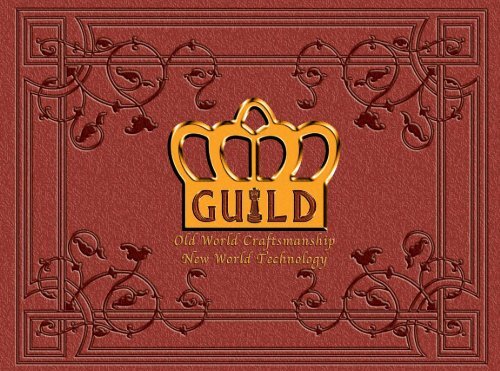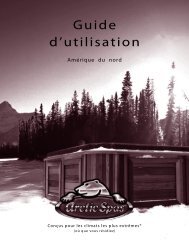Many billiard tables Are Just Not Designed To - Arctic Spas
Many billiard tables Are Just Not Designed To - Arctic Spas
Many billiard tables Are Just Not Designed To - Arctic Spas
Create successful ePaper yourself
Turn your PDF publications into a flip-book with our unique Google optimized e-Paper software.
Thank you for your interest in GUILD ® Billiard Products.<br />
We hope that this catalogue helps you to learn a little bit more<br />
about <strong>billiard</strong> products in general and why choosing a<br />
Guild table can provide generations of enjoyment.<br />
Since the Middle Ages, <strong>billiard</strong>-like games have been a leisurely<br />
past-time enjoyed from simple peasantry to kings. The game has<br />
endured because of its mutual appeal and fairness to all.<br />
Guild ® shares the old world’s belief in quality hand craftsmanship,<br />
where labourious hours of painstaking, intricate work marked<br />
excellence. By combining new world technology with this<br />
craftsmanship, we’ve created one of the finest lines of <strong>tables</strong> ever<br />
built; capable of being passed through the generations .<br />
Our philosophy is to over-build everything better than<br />
the best that any competitor can offer.<br />
Read on and learn for yourself why Guild ® is your only<br />
choice in Billiards!<br />
<strong>Many</strong> <strong>billiard</strong> <strong>tables</strong> are just not designed to stand the test<br />
of time. At Guild ® our passion is creating the finest playing<br />
<strong>tables</strong> available! Our philosophy is something that plays this<br />
well should be built in such a way as to pass from generation<br />
to generation as a cherished heirloom. We firmly believe that<br />
overbuilt is better and solid hardwood is the only way to go.<br />
(After all, grandma never passed down her old chipboard<br />
dresser!)<br />
Make the decision. You and your family will enjoy a<br />
Guild ® table for generations to come.
Oversized Bodies<br />
Guild ® Billiards all have over-sized body<br />
construction. The wider, longer body makes for a<br />
wider, longer leg stance and provides a larger surface<br />
area for the slate to sit on. The wider the leg stance,<br />
the more stable the table. Other <strong>tables</strong> have narrower<br />
bodies and leg stance, which is less stable. They also<br />
require flimsy extensions (usually plywood) in order<br />
to attach the slate. Oversized, thicker bodies give<br />
you far more furniture for your money.<br />
Check Out Our Legs<br />
You will see thicker heavier and more robust<br />
legs that are capable of supporting the added<br />
weight of our thicker, larger <strong>tables</strong>. At Guild ® ,<br />
we build, we do not outsource. Every Guild ®<br />
leg is HANDCRAFTED in our own factory,<br />
creating a unique piece of furniture out of<br />
every table.<br />
FIRM Bracketing System<br />
Fixed Inset Routered Mounting System<br />
We have routered the cabinet so that all brackets that hold the body together are<br />
inset into the wood (similar to door hinges). This way the brackets are being<br />
held in place by the wood itself and not relying just on hardware. Movement<br />
caused by the loosening of hardware is now greatly minimized as the brackets<br />
cannot shift. When brackets are simply screwed to a flat surface they can<br />
move and shift quite easily. Minimizing movement<br />
increases the life of your table.<br />
Bolted Body Construction<br />
+ Triple Leg Bolt<br />
Guild ® bodies and legs have now improved to<br />
be 100% bolted together. NO MORE WOOD<br />
SCREWS. Bolting cabinets and legs are MANY<br />
times stronger then wood screws and Guild ® <strong>tables</strong><br />
can be assembled and dissassembled without any deterioration of<br />
the wood. Also improved is the triple leg bolting system. Most<br />
movement in many <strong>tables</strong> is between the body and legs where<br />
there is normally only one bolt. Guild ® now uses three leg bolts<br />
and has virtually eliminated movement between the legs and the<br />
body.
Minimize the movement. Maximize the Life!<br />
All Guild ® Billiards have either 40 mm (1.6”) or 50 mm (2”) thick body construction<br />
as a standard. THICKER IS BETTER. <strong>Many</strong> other <strong>tables</strong> have only 19 mm (3/4”) to 32mm (1 1/4”)<br />
construction. Thicker cabinets minimize overall movement. Movement causes long-term problems:<br />
screws loosen causing hardware to shift and the table to go out of level, making play unreliable and<br />
leading to deterioration of the wood itself. All Guild ® <strong>tables</strong> are made from kiln dried North<br />
American solid hardwoods. NO plywood, NO chipboard, NO veneers, NO laminates. ONLY<br />
thick solid hardwood! Non hardwood <strong>tables</strong> move more easily than solid hardwood<br />
ones, as a result overall deterioration happens even more rapidly. At Guild ®<br />
we build furniture quality <strong>tables</strong> that last, using old world construction<br />
techniques that have proven they stand the test of time. Quality<br />
assurance for your family and the generations to come.<br />
We want to be the most solid table in the industry, so we have<br />
oversized all of our hardware and bracketing. 1. <strong>To</strong> hold our<br />
body and legs together tighter than any other table, we use a<br />
single 3.5mm (1/8”) powder coated steel corner bracket. This 3dimensional<br />
design is much stronger because it limits the movement<br />
compared to other <strong>tables</strong> multiple brackets. 2. Dome tooth washers<br />
True Support<br />
All Guild ® <strong>tables</strong> contain a 50 mm x 150 mm (2”x 6”) center slate beam<br />
that runs the length of the table. This is a solid beam that is notched with<br />
the two cross beams to provide extra support for the slate as well as to<br />
keep the cabinet square. <strong>Many</strong> <strong>tables</strong> do not have center beams and<br />
those that do often use 50 mm x 100 mm (2” x 4”) soft woods or<br />
plywood. In many cases the center slate and cross slate beams are<br />
not solid, but are instead cut and rejoined using hardware, this again<br />
allows movement at the joints, is not nearly as strong and greatly<br />
decreases their effectiveness.<br />
Hardware Beyond Compare are standard on all bolted connections. This cup<br />
shaped washer provides strong gripping power<br />
and compression. Commonly used flat washers<br />
simply bend when tightened and have no capacity<br />
to hold pieces tight. Dome tooth washers have<br />
approximately two full thread turns of reverse<br />
pressure in which to hold things tight. 3. All<br />
leg and rail bolts are 12 mm (1/2”).<br />
Industry average is 9.5 mm (3/8”). A<br />
9.5 mm bolt can tighten to 41 N.m (30<br />
ft/lb) of torque. A 12 mm bolt can be<br />
tightened to 102 N.m (75 ft/lb.) That<br />
is two and a half times tighter!
True Response<br />
The consistency, longevity, response and play<br />
quality of a cushion are best with pure gum<br />
rubber. <strong>Many</strong> companies use cushions where the<br />
gum rubber is mixed with fillers. These cushions<br />
get hard and dried out with time resulting in<br />
inconsistent play.<br />
Our rail fronts are precision machine routered to<br />
create a guide for attaching the cushion to the<br />
rail. This system results in a consistent and level<br />
installation of the cushion and eliminates the<br />
errors of other methods. Like our bodies, all rails<br />
are kiln dried North American solid hardwood.<br />
Guild ® <strong>tables</strong> also feature 152 mm (6”) wide rails<br />
Ultimate Rail Anchoring System<br />
The tighter you can hold a rail to the slate, the<br />
quicker and more accurate the response of the<br />
ball. Our floating nut block is incomparable in<br />
strength to the T nuts and floating nut plates used<br />
on other <strong>tables</strong>. It has the thickness of the sleeve<br />
portion of a T nut and two times surface area of a<br />
nut plate! (This means our nut block has at least<br />
7 times the tensile strength of either the T nut or<br />
nut plate!) Each rail section is secured to the slate<br />
at three points. The 12 mm (1/2”) bolt is threaded<br />
instead of 127 mm (5”). Wider rails are better for<br />
setting up your shot because you have a larger surface<br />
area for your hand. It is also more attractive and gives<br />
you more furniture for your money. <strong>To</strong> finish our rails<br />
we use Mother of Pearl diamond sights.<br />
through the dome tooth washer and the slate and then<br />
tightened into the nut block (anchored within the<br />
rail). Using our over-specified and specially designed<br />
hardware allows us to mount our rails more tightly<br />
to the slate than any other table in the industry. The<br />
result: a rail that plays truer and will do so for longer<br />
than any other industry table anywhere.<br />
Nut Block<br />
Nut Plate T-Nut
Thicker Slate is Better<br />
Balls roll further, faster and quieter. The extra<br />
weight is also a benefit as heavier <strong>tables</strong> are harder<br />
to accidentally shift (remember: minimize the<br />
movement, maximize the life). All slate is wood<br />
backed to prevent vibration through the body for<br />
extremely quiet play. Standard slate thickness on all<br />
Guild ® <strong>tables</strong> is 30 mm (1 1/4”).<br />
Old World Hand-Rubbed Finish<br />
Taking the time to rub in stain makes for better<br />
absorption into the wood. Some manufacturers<br />
simply make a few passes with a stain gun. The<br />
finish on every Guild ® table is truly Old World<br />
craftsmanship. The Old World finish utilizes<br />
time honoured traditional techniques to provide<br />
a look that is both beautiful and enduring. This<br />
painstaking process involves hand-rubbing the<br />
stain onto the entire table followed with multiple<br />
finish and lacquer coats! Between each coat the<br />
table is lightly hand-sanded ensuring a perfectly<br />
smooth final finish that is virtually flawless.<br />
Pockets That Match<br />
All Guild ® pockets come standard as<br />
leather covered cast iron. All leather is<br />
stained and etched to match the table finish<br />
at no extra charge.<br />
The Old World process uses only oil-based<br />
stains, which lasts longer than a water-based<br />
stain and holds up better to wear and tear. (Like<br />
leaving wet glasses on your wood.) <strong>Many</strong><br />
companies prefer water based finishes as it<br />
dries faster and speeds production. At Guild ®<br />
our Old World philosophy dictates that you<br />
cannot rush perfection: we will wait the time<br />
necessary to produce the best finish possible.<br />
Guild ® Billiards are available in four standard<br />
finishes.<br />
Natural<br />
Medium<br />
Pecan<br />
Mahogany
The origin of Billiards is<br />
at best vague, but most<br />
scholars agree that<br />
in its earliest form it<br />
was played on a lawn,<br />
not unlike croquet.<br />
Ancient manuscripts<br />
allude to the existence<br />
of such games in ancient<br />
Greece as early as 4 th<br />
century B.C. Other texts<br />
reference similar games<br />
throughout ancient Asia,<br />
the middle east and<br />
medieval Europe.<br />
Though there were many<br />
sports played with balls,<br />
maces, clubs and bats<br />
during the Middle Ages,<br />
and even back to ancient<br />
Egypt, records have only<br />
shown one game that is<br />
directly related to Billiards.<br />
Sometimes known as<br />
Ground Billiards, the<br />
game was played on a<br />
small outdoor court with<br />
a hoop at one end and an<br />
upright stick at the other.<br />
This croquet-like pastime<br />
required people to strike<br />
balls around the court<br />
with maces.<br />
The Crusader features the simple elegance of a single<br />
arched body, accented with straight deep routered<br />
lines. Rounded pillar legs finish this design while<br />
invoking images of imperial architecture.
The Templar takes its style from the medieval courts of western<br />
Europe. The classic single arched body, deep routered lines and<br />
graceful Queen Anne legs, all hand-stained to a deep<br />
gloss, create a timeless addition<br />
to any decor.<br />
At some point in the<br />
1400s, people began<br />
to play a version<br />
of ground <strong>billiard</strong>s<br />
indoors on a table. It’s<br />
likely that the green<br />
cloth was supposed to<br />
represent the lawn from<br />
which the game had<br />
been stolen. Presumably<br />
players did not want<br />
to stop playing when<br />
the long nights and<br />
inclement weather of<br />
winter set in.<br />
The earliest recorded<br />
evidence found for the<br />
existence of Billiards<br />
played on a table was<br />
in a 1470 inventory<br />
of items purchased<br />
by King Louis XI of<br />
France (King between<br />
1461 and 1483). Listed<br />
were “<strong>billiard</strong> balls and<br />
<strong>billiard</strong> table for pleasure<br />
and amusement.”
Once games such as<br />
Billiards were brought<br />
indoors and elevated<br />
to tabletop level it<br />
became necessary to<br />
have a raised border<br />
to stop the balls from<br />
falling onto the floor.<br />
Thus, the cushion was<br />
developed. At first the<br />
<strong>tables</strong> were made entirely<br />
of wood, with no cloth,<br />
and no pockets. Hoops<br />
were used as the targets<br />
(similar to croquet).<br />
Later cloth lined the bed<br />
of the table and the early<br />
cushions which later<br />
again were covered with<br />
several layers of felt.<br />
Several early players of<br />
note were Mary Stuart,<br />
Queen of Scots (1542-<br />
1587), King Louis<br />
XIV (1643-1715),<br />
Marie Antoinette and<br />
her husband King Louis<br />
XVI.<br />
The Conquest’s bold classic styling is revealed in the single arched<br />
body and deeply flowing routered lines. This solid wood body has<br />
been stained and hand-rubbed to a flawless finish. Handsome<br />
handcrafted Ram’s head legs finish this<br />
strong stately design.
The Paladin marries the clean look of the single arched body with<br />
the bold styling of ball and claw legs. With an oversized<br />
body and wider, longer leg stance, this table makes it<br />
easy to conjure up mythical images of knights<br />
battling dragons.<br />
By the early 1600s,<br />
people in mainland<br />
Europe sometimes<br />
used the handle (or<br />
‘queue’ – tail in<br />
French; later ‘cue’)<br />
of the mace to strike<br />
the ball instead of the<br />
larger mace head. This<br />
was more convenient,<br />
especially when the ball<br />
to be struck was near<br />
the edge of the table and<br />
this method gradually<br />
took over. It wasn’t so<br />
much that an implement<br />
called the cue replaced<br />
the mace – more that<br />
the pointy end of the<br />
mace gradually became<br />
thinner and more used<br />
while the thick end of<br />
the mace became less<br />
used. By 1675 Billiards<br />
was very popular, and<br />
in England the first<br />
known rule book was<br />
published that year.
Around 1835, rubber<br />
replaced the felt<br />
‘stuffing’ of early<br />
cushions. However,<br />
vulcanizing had not<br />
yet been invented<br />
and the rubber was<br />
glued to the wooden<br />
cushion in thin strips.<br />
Before vulcanizing,<br />
rubber was only pliant<br />
above room temperature<br />
and so the cushions<br />
had to be heated before<br />
play. Devices similar<br />
to long, thin, metal<br />
hot water bottles were<br />
used for this. This was,<br />
of course, not really<br />
satisfactory, and shortly<br />
after the development<br />
of the vulcanizing<br />
process, vulcanized<br />
rubber cushions were<br />
introduced by John<br />
Thurston, a pioneering<br />
<strong>billiard</strong> table maker<br />
of the time. These new<br />
cushions revolutionized<br />
the performance of that<br />
generation of <strong>billiard</strong><br />
<strong>tables</strong>.<br />
The Cavalier’s single arched body and smooth<br />
routered lines gives prominence to traditional<br />
15th Century craftsmanship. Square<br />
tapered legs, carefully routered,<br />
complete this enduring<br />
heirloom.
A beautifully balanced double-arched body and sweeping<br />
routered lines are key elements to the Vanguard’s noble<br />
design. The scrolled Rams head legs with clamshell<br />
accents join perfectly to the body, without a leg<br />
plate, for a flowing artistic<br />
appearance.<br />
The first <strong>billiard</strong> balls<br />
were predominately<br />
made of wood, which<br />
was easily turned and<br />
inexpensive. Ivory balls<br />
came into use in the<br />
early 17th century and<br />
were preferred in spite<br />
of their shortcomings.<br />
Ivory from elephant<br />
tusks had to be seasoned<br />
- sometimes for up to<br />
two years! They were<br />
also liable to absorb<br />
moisture, lose their shape<br />
and had to be broken<br />
in carefully. Because of<br />
the flaws of an ivory<br />
ball, there was a rush<br />
to find a replacement<br />
during the latter part of<br />
the 19 th century. The<br />
development of the<br />
plastics industry saw the<br />
introduction of several<br />
different compounds<br />
for <strong>billiard</strong>s and snooker<br />
balls until the first cast<br />
phenolic resin balls<br />
were introduced in the<br />
1950’s.
Slate beds were first<br />
introduced into English<br />
<strong>billiard</strong>s in the 1830’s<br />
although they had been<br />
used in Europe much<br />
earlier. By 1840 slate<br />
had generally succeeded<br />
wood as the table top of<br />
choice.<br />
The first leather cue-tip<br />
was perfected in 1807 by<br />
Francois Mingaurd, who<br />
was a political prisoner<br />
in France at the time.<br />
Mingaurd discovered<br />
that he could aim more<br />
accurately if he rounded<br />
the cue tip with a file,<br />
thereby revolutionizing<br />
the game by allowing<br />
significant control of the<br />
cue ball through spin.<br />
However, the leather<br />
tip was only partly<br />
successful as it became<br />
shiny with use and had to<br />
be replaced often. Chalk<br />
for that tip did not appear<br />
until 20 years later.<br />
Crisp, sword straight lines and restrained artisan pride<br />
characterize the Chapterhouse’s unadorned charm.<br />
A perfect balance is achieved between line and<br />
curve by the subtle placement of its<br />
gently arched legs.
Precision architecture meets renaisannce scuplture in the Regent’s<br />
majestic 17th century design. The blend of classical lines and<br />
artistic flair can be appreciated throughout this table’s<br />
solid hardwood rails, body and legs, remaining robust<br />
without being overpowering.<br />
The word ‘pool’ means<br />
a collective bet, or ante.<br />
<strong>Many</strong> non-<strong>billiard</strong><br />
games, such as poker,<br />
involve a pool but it<br />
was to pocket <strong>billiard</strong>s<br />
that the name became<br />
attached. The term<br />
‘pool room’ now means<br />
a place where pool is<br />
played, but in the 19th<br />
century a ‘poolroom’<br />
was a betting parlor for<br />
horse racing. Pool <strong>tables</strong><br />
were installed so patrons<br />
could pass the time<br />
between races. During<br />
the 1840s, <strong>billiard</strong>s<br />
became associated<br />
with pool parlors in<br />
large cities, the two<br />
became connected in<br />
the public mind, but the<br />
unsavory connotation of<br />
‘pool room’ came from<br />
the betting that took<br />
place there, not from<br />
<strong>billiard</strong>s.
It wasn’t until the early<br />
19th century that American<br />
craftsmen began to make<br />
Billiard <strong>tables</strong>. Although<br />
at the time the<br />
average man<br />
certainly couldn’t<br />
afford one, he<br />
could play on a<br />
public table, at<br />
least in New York<br />
City, where there<br />
were eight <strong>tables</strong> in<br />
coffeehouses and hotels by<br />
1808 and about two-dozen<br />
in 1824. By 1830 public<br />
rooms devoted entirely to<br />
<strong>billiard</strong>s appeared.<br />
The American <strong>billiard</strong><br />
industry and the incredible<br />
rise of popularity of the<br />
game are due to Michael<br />
Phelan, the father of<br />
American <strong>billiard</strong>s.<br />
Phelan emigrated from<br />
Ireland and in 1850 wrote<br />
the first American book<br />
on the game. He was<br />
influential in devising<br />
rules and setting standards<br />
of behavior.<br />
The quality of this table is matched only by it’s<br />
affordability. Holding true to the Guild® line’s<br />
reputation for unmatched beauty and available<br />
in three different leg styles, the Squire will be at<br />
home in any setting.<br />
Available in 8’ Only
The Page is a sleek arch furniture design with tall<br />
square tapered legs that feature matching router<br />
work on all the wood. This table’s wider stance<br />
lends it a sturdiness matched only by it’s<br />
elegance.<br />
Available as an 8’ Pecan Finish Only
Guild Billiards offers the industry’s only solid granite <strong>billiard</strong> table. Center<br />
your gamesroom around a work of art carved from some of the hardest granite<br />
available. Available in either a light or dark finish this one of a kind<br />
table will have your neighbors talking.<br />
Also Available in Dark Granite
Accessories Package<br />
Comes with everything you need<br />
to enjoy your new Guild® table!<br />
<strong>Not</strong>e: Also includes a dust cover.<br />
Cue Rack<br />
Available in four finishes to<br />
match your Guild® table:<br />
Medium, Pecan,<br />
Natural and Mahogany.<br />
(left to right)<br />
Ultra Cue Rack Deluxe Cue Rack Standard Cue Rack Floor Cue Rack Two-Piece<br />
Cue Rack
All of our<br />
G a m e s<br />
R o o m<br />
Furniture and<br />
A c c e s s o r i e s<br />
are made with<br />
North American Kiln<br />
dried hardwood. This<br />
hardwood is selected<br />
for its grain, color<br />
and quality. Each<br />
component is carefully<br />
crafted and finished to<br />
produce a lasting piece<br />
of furniture. The stain is<br />
applied in many layers.<br />
It is hand rubbed and<br />
sanded between each<br />
layer to gie a durable,<br />
beautiful finish. No<br />
matter what pieces of<br />
furniture you choose<br />
from in our line-up, they<br />
will be sure to match<br />
in quality, color, and<br />
durability: the perfect<br />
way to finish any Games<br />
Room.<br />
The same care that goes into our <strong>billiard</strong> <strong>tables</strong> is also available in our accessories. <strong>To</strong> products<br />
crafted of prime solid American Ash, we add the luster and depth of a hand-rubbed stain<br />
finish. Four beautiful and enduring colors (Natural, Pecan, Medium, and Mahogany) allow<br />
you to select the perfect choice to match or complement your Guild® table and your room décor.<br />
92” Tavern Style Bar<br />
~ 2336L x 610W x 1092H<br />
~ 1 cupboard with adjustable shelf<br />
~ 1 lockable bottle storage drawer with serving rail<br />
in front<br />
~ 1 ice bucket<br />
~ Room for small bar refrigerator<br />
~ Brass foot plate<br />
~ Raised panel arch design<br />
72”/92” Traditional Bar<br />
~ 1828L x 724W x 1092H<br />
~ 2 cupboards with adjustable shelves<br />
~ 1 drawer<br />
~ 1 wine rack<br />
~ 4 bottle wells<br />
~ 1 ice bucket<br />
~ 1 condiment tray<br />
~ Wooden foot rail to match<br />
~ Raised panel arch design
Our new Poker Tables are made of the same North American solid<br />
hard wood as the Guild pool Tables, so stains will match perfectly.<br />
As well the legs come in our most popular styles. It can be ordered<br />
with Ball and Claw, Rams Head and the Queen Anne, so it<br />
will matchup with six diffrent pool <strong>tables</strong>. This table features drink<br />
holders, chip slots, a pull<br />
54” Hex Games Table<br />
out drawer for each player,<br />
as well as has the ability<br />
to flip over for a great<br />
everyday dining room table!!<br />
This versatile poker<br />
table will make a great<br />
games room addition.<br />
Poker Chair<br />
The Poker Chairs are made with genuine<br />
leather (black only). Solid North American<br />
hard wood with all 4 stains available and accents<br />
that are hand carved.These chairs are<br />
telescopic, swivel and can tilt back with a<br />
simple pull of a pin. So kick back and relax<br />
with all your winnings.<br />
54” Round Games Table<br />
Bar Chair<br />
Spectator Chair<br />
Our Spectators Chairs are again<br />
solid North American hard wood<br />
with all 4 stains available. They<br />
are a solid four leg construction<br />
with genuine leather black only).<br />
These chairs feature a drink holder<br />
on one armrest and a notch<br />
carved out of the other armrest to<br />
hold your cue.
Guild ® Lifetime Warranty<br />
It’s Simple!<br />
Guild® Billiards warrants its <strong>billiard</strong> <strong>tables</strong>, to the original owner, that if any defects in materials or workmanship<br />
appear during the time that the original purchaser owns the table, Guild® Billiard will repair or replace the defective<br />
part.<br />
Table Size 48” Cue 52” Cue 58” Cue<br />
(playing surface)<br />
4’ x 8’ 11’10” x 15’4” 12’6” x 16’0” 13’6” x 17’0”<br />
4.5’ x 9’ 12’4” x 16’4” 13’0” x 17’0” 14’0” x 18’0”<br />
(recommended room size)
1-877-777-1577<br />
www.guildproducts.com<br />
Printed in Canada












